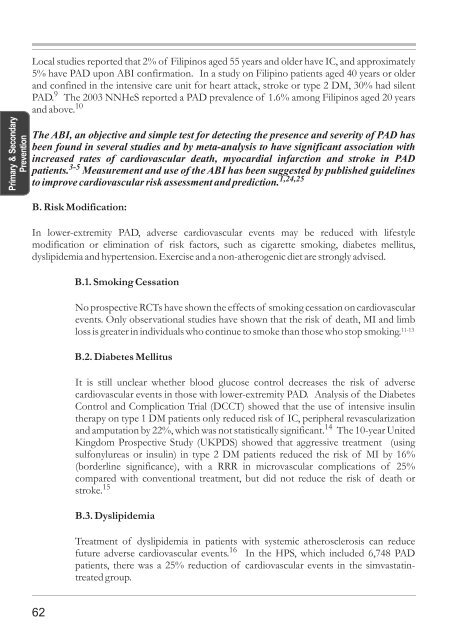Front Panel Painting “LIFE” By William T Chua MD
FREE download - Stroke Society of the Philippines
FREE download - Stroke Society of the Philippines
Create successful ePaper yourself
Turn your PDF publications into a flip-book with our unique Google optimized e-Paper software.
Primary & Secondary<br />
Prevention<br />
Local studies reported that 2% of Filipinos aged 55 years and older have IC, and approximately<br />
5% have PAD upon ABI confirmation. In a study on Filipino patients aged 40 years or older<br />
and confined in the intensive care unit for heart attack, stroke or type 2 DM, 30% had silent<br />
PAD. 9 The 2003 NNHeS reported a PAD prevalence of 1.6% among Filipinos aged 20 years<br />
and above. 10<br />
The ABI, an objective and simple test for detecting the presence and severity of PAD has<br />
been found in several studies and by meta-analysis to have significant association with<br />
increased rates of cardiovascular death, myocardial infarction and stroke in PAD<br />
patients. 3-5 Measurement and use of the ABI has been suggested by published guidelines<br />
to improve cardiovascular risk assessment and prediction. 1,24,25<br />
B. Risk Modification:<br />
In lower-extremity PAD, adverse cardiovascular events may be reduced with lifestyle<br />
modification or elimination of risk factors, such as cigarette smoking, diabetes mellitus,<br />
dyslipidemia and hypertension. Exercise and a non-atherogenic diet are strongly advised.<br />
B.1. Smoking Cessation<br />
No prospective RCTs have shown the effects of smoking cessation on cardiovascular<br />
events. Only observational studies have shown that the risk of death, MI and limb<br />
loss is greater in individuals who continue to smoke than those who stop smoking. 11-13<br />
B.2. Diabetes Mellitus<br />
It is still unclear whether blood glucose control decreases the risk of adverse<br />
cardiovascular events in those with lower-extremity PAD. Analysis of the Diabetes<br />
Control and Complication Trial (DCCT) showed that the use of intensive insulin<br />
therapy on type 1 DM patients only reduced risk of IC, peripheral revascularization<br />
and amputation by 22%, which was not statistically significant. 14 The 10-year United<br />
Kingdom Prospective Study (UKPDS) showed that aggressive treatment (using<br />
sulfonylureas or insulin) in type 2 DM patients reduced the risk of MI by 16%<br />
(borderline significance), with a RRR in microvascular complications of 25%<br />
compared with conventional treatment, but did not reduce the risk of death or<br />
stroke. 15<br />
B.3. Dyslipidemia<br />
Treatment of dyslipidemia in patients with systemic atherosclerosis can reduce<br />
16<br />
future adverse cardiovascular events. In the HPS, which included 6,748 PAD<br />
patients, there was a 25% reduction of cardiovascular events in the simvastatintreated<br />
group.<br />
62



